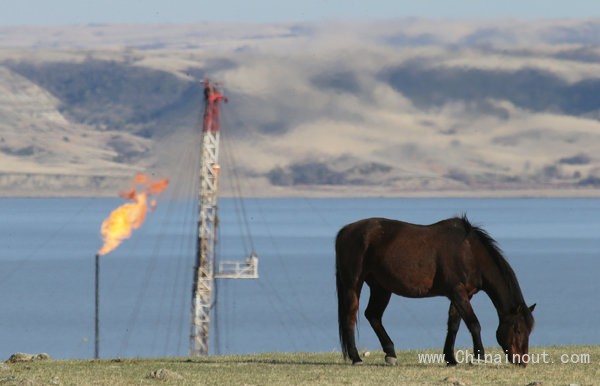油价从6月底的每桶逾107美元(约合658元人民币)降至约每桶66美元,这让很多专家感到担忧。他们提到了价格下跌及国外社会、政治动乱带来的风险,更不用说美国中部地区——从德克萨斯州到北达科他州及艾伯塔的繁荣发展的油田面临的经济威胁。
但从历史来看,对于那些不靠石油盈利的人,也就是世界上的大部分人来说,很难把油价下跌看作坏消息。
“油价每次突然出现变动,人们都会说,‘就这样了,我们完蛋了,’”《探秘:能源、安全和重塑当今世界》(The Quest: Energy, Security and the Remaking of the Modern World)的作者、能源咨询公司IHS的副董事长丹尼尔·耶金(Daniel Yergin)说。“人们似乎忘了,石油是一种商品,与其他商品一样,其价格是由供求决定的,会出现周期性变动。”
虽然油价的突然上升好像获得了更多的媒体及政界关注——耶金指出西奥多·罗斯福(Teddy Roosevelt)总统曾在1908年警告称石油“即将耗尽”,但石油过剩和油价下跌的情况出现的频率似乎差不多。2008年,金融危机及全球需求的减少导致油价从7月的每桶145美元跌至12月中旬的每桶33美元。虽然每桶33美元的价格现在看起来很便宜,但在1998年和1986年,油价更是一度跌至每桶10美元以下。因此,最近一次下跌的跌幅在过去30年间排名第四。
虽然情况并非完全相同,而且廉价石油带来的影响很难与其他经济因素分离开来,每次下跌带来的广泛后果都是相同的:刺激了全球经济的发展。据耶金估计,如果油价停留在每桶80美元,全球经济产出今年将额外增长0.4%。他表示,如果油价低于80美元,“我们可能会将这个数字调至0.5%。”
“汽油的全国均价已经低至每加仑3美元,而且还将继续下跌,”原油价格信息服务公司( Oil Price Information Service)首席石油分析师登顿·辛克格拉纳(Denton Cinquegrana)说。“消费者将有更多的钱进行消费,我们预计,这种情况会持续整个冬天,可能还会持续到2016年。”
但现在估计购物季的情况仍然为时过早,11月的汽车销售年化同比增长4.6%,年化销量达到1720万辆。销售量排名前三的都是皮卡:福特(Ford)F-150、雪佛兰西尔维拉多(Chevrolet Silverado)和道奇公羊(Dodge Ram)。虽然与之前的车型相比,其节能性已经有所提高,但与丰田普锐斯(Toyota Prius)或凯迪拉克(Cadillac)轿车相比,这些汽车的油耗仍然非常大。
除了对消费者有利,前几次的油价下跌结果都促使股价上涨,但能源领域的股票除外。1986年,标准普尔500指数(Standard & Poor’s 500)上涨了18.67%,牛市一直持续到1991年经济衰退之前。1998年,标准普尔500指数攀升了25.58%,接下来一年上涨了21%。虽然股市在2008年陷入崩溃,但在2009年出现大幅上扬。
一个警告是,廉价石油或许会导致市场出现泡沫。1986年油价下跌,一年之后,也就是在1987年10月,股市遇到了著名的黑色星期一(Black Monday),但很快就恢复了。1998年油价下降,两年之后,科技业泡沫达到顶峰,并于2000年3月破灭。一些专家警告称新的资产泡沫正在形成。
耶金表示,今年油价下跌的情况与1986年的情况非常相似。1998年及2008年的下跌都是由意想不到的金融危机引发的,比如1998年对冲基金长期资本管理公司(Long-Term Capital Management)的崩溃及亚洲债务危机,2008年雷曼兄弟(Lehman Brothers)的破产,以及接下来的大衰退(Great Recession)。而在1986年,北海与阿拉斯加的石油供应激增,压低了油价,这些地区不受石油输出国组织(Organization of the Petroleum Exporting Countries)的影响。
今年,油价下跌的原因在于俄罗斯及中东地区带来的破坏威胁的减弱,以及欧洲、亚洲等地区经济的放缓,尤其是美国及加拿大地区石油产量的增加。“这一次的革新是水力压裂技术,”能源咨询公司董事长、前财政部(Treasury Department)能源政策办公室(Office of Energy Policy)主任菲利普·弗莱杰(Philip Verleger)说。“美国石油产量的突然增加极大地改变了市场动态。与石油输出国预料的2014年的情况相比,它们失去了三分之一的市场份额。”
石油输出国组织于感恩节召开了会议,但是其成员国甚至没有在口头上表示需要减少产量或执行价格控制,这让市场颇为震惊。当天,在国际市场上交易的石油的价格下跌了大约6.5%。“他们的策略就是让油价下跌,把生产成本较高的生产者挤出市场,”弗莱杰说。“这是一场争夺市场份额的战争。”
对于美国而言,低油价并非是件绝对的好事,因为它现在是世界上最大的产油国,而且或许很快就会变成石油出口国。OPEC的策略可能就是让价格下跌到一个点,到达使北美的页岩油产量和采自焦油砂的石油产量不再在经济上具有可行性的程度。“但是,这是一个危险的游戏,”辛克格拉纳说。“多亏了科技,页岩油生产商一直在降低他们的生产成本。”据花旗集团全球市场(Citigroup Global Markets)大宗商品研究的负责人爱德华·莫尔斯(Edward Morse)估计,连沙特阿拉伯都需要每桶98美元油来平衡预算。
对于沙特阿拉伯和其他主要产油国来说,“石油生产和出口是政府收入的一个主要来源,”莫尔斯在最近的一份研究报告中写道。“为了用石油收益来平衡政府预算,所需油价要远高于每桶70~90美元的范围,其中几个国家还要求把油价设定在远远超过每桶100美元的程度。
据他估计,数十年来,在乌戈·查韦斯(Hugo Chávez)的左翼政府领导下,委内瑞拉任人唯亲,能源部门管理不善。今年,它需要把油价设定在每桶161美元,才能达到收支平衡。“在经济管理不善的问题上,委内瑞拉是一个世界级的实例,”耶金指出。油价低于每桶80美元“将是毁灭性的”。
此外,还有俄罗斯。俄罗斯本周承认,由于西方因为乌克兰问题对其施加制裁,再加上石油收益降低,其经济已经陷入衰退。俄罗斯有超过一半的国家预算都来自石油和天然气收益。本周,俄罗斯总统弗拉基米尔·普京(Vladimir Putin)取消了通往欧洲的天然气管道计划——俄罗斯对这条经过保加利亚和塞尔维亚、绕开乌克兰的管道期待已久。
普京和查韦斯都是在1998年油价暴跌带来经济动荡后上台执政的。1999年,俄罗斯发生主权债务违约后,普京接替了鲍里斯·叶利钦(Boris Yeltsin)的职位。他发誓要恢复俄罗斯的金融信用,实现经济现代化。究竟俄罗斯最近的油价暴跌和衰退是否会对他的地缘政治冒险主义产生影响,目前仍有待观察。1998年,查韦斯当选,当时社会动荡,而且由于OPEC在实行减产,石油收益也出现下跌。
普京和查韦斯的接班人尼古拉斯·马杜罗(Nicolás Maduro)一直都是美国的强烈批评者。美国的另外两个宿敌——一半预算收入都来自石油出口的伊朗,以及大部分活动资金都来自石油销售的激进组织伊拉克与叙利亚伊斯兰国(Islamic State in Iraq and Syria,简称ISIS)——都将因为低油价而陷入困境。辛克格拉纳说,低油价所产生的地缘政治影响,似乎符合美国外交政策的利益,“有些阴谋论者声称,美国和沙特阿拉伯想惩罚俄罗斯与伊朗。”
此外,世界上规模最大的两个新兴经济体——中国和印度——都是能源净进口国,低价格应该对他们的经济有好处。
从历史经验来看,油价最近的暴跌将产生深远影响。“你必须关注潜在的社会和政治动荡,”耶金说。“我们正处在一个周期的开端,很可能有些后果是无法预见的。但是对于整体全球经济而言,我认为这非常有益。11月油价下跌,就意味着12月,收银机里会出现更多现金。”(中国进出口网)
The plunge in oil prices — to about $66 a barrel from over $107 in late June — has many pundits wringing their hands. They have cited the risks of falling prices and social and political unrest overseas, not to mention the economic threat to the booming mid-American oil basin, running from Texas to North Dakota and Alberta.

But if history is any guide, it’s hard to see falling oil prices as anything but good news for everyone whose fortunes aren’t tied to oil, which is to say, most of the world’s population.
“Every time you get a sudden move in oil prices, people say, ‘This is it, we’re finished,’ ” said Daniel Yergin, the author of “The Quest: Energy, Security and the Remaking of the Modern World,” and vice chairman of the energy consulting firm IHS. “People seem to forget that oil is a commodity, and like other commodities, its price moves in cycles set by supply and demand.”
Although sudden price spikes seem to receive more media and political attention — Dr. Yergin noted that Teddy Roosevelt warned of the “imminent exhaustion” of oil in 1908 — oil gluts and price drops seem to happen with similar regularity. In 2008, oil went from $145 a barrel in July to $33 in mid-December, a plunge precipitated by the financial crisis and a collapse in global demand. While $33-a-barrel oil seems cheap now, in 1998 and 1986, oil dropped below $10 a barrel. That makes this latest decline the fourth precipitous fall in the last 30 years.
While circumstances are never exactly the same, and the impact of cheap oil can be difficult to isolate from other economic factors, the broad consequence in each of these instances was the same: They stimulated global economic growth. Dr. Yergin estimated that global economic output would grow this year by an additional four-tenths of a percent with oil prices at $80 a barrel. If oil stays below $80, he said, “We may revise that to five-tenths.”
“The national average for a gallon of gas is already below $3 and headed lower,” said Denton Cinquegrana, chief oil analyst for the Oil Price Information Service. “Consumers will have more money to spend, and we expect to see this extend through the winter. It may well persist into 2016.”
While it’s still too early to assess the holiday shopping season, November auto sales surged 4.6 percent from a year earlier to an annualized rate of 17.2 million vehicles. The top three sellers were pickup trucks: the Ford F-150, Chevrolet Silverado and Dodge Ram. While their fuel efficiency has improved over previous models, they’re still gas-guzzlers compared with a Toyota Prius or even a Cadillac sedan.
Apart from the benefits for consumers, previous bouts of low oil prices turned out to be great for stock prices, with the exception of the energy sector. In 1986, the Standard & Poor’s 500-stock index rose 18.67 percent in a bull run that lasted until the recession of 1991. In 1998, the index rose 25.58 percent and 21 percent the year after. And even though stocks collapsed in 2008, they staged a huge rally in 2009.
One caveat is that cheap oil may lead to pockets of excess. A year after the 1986 plunge, in October 1987, the stock market crashed on what became known as Black Monday, though it soon recovered. The two years after the 1998 dro led to the peak of the technology bubble, which popped in March 2000. Some pundits are now warning of new asset bubbles in the making.
This year’s price decline is most nearly analogous to 1986, Dr. Yergin said. Oil price plunges in 1998 and 2008 were set off by unexpected financial crises — the failure of the hedge fund Long-Term Capital Management and the Asian debt crisis in 1998, and the collapse of Lehman Brothers in 2008 and the ensuing Great Recession. In 1986, a surge in new supplies from the North Sea and Alaska, areas beyond the influence of the Organization of the Petroleum Exporting Countries, drove down prices.
This year, the precipitating factor has been the waning of threats of disruption from Russia and the Middle East, slowing economies in Europe and Asia and, above all, a surge in production from the United States and Canada. “This time, the innovation is fracking,” said Philip Verleger, president of an energy consulting firm and former director of the Office of Energy Policy in the Treasury Department. “The sudden surge in U.S. oil production has profoundly changed the dynamics of the markets. The oil exporters have lost a third of the market they thought they’d have in 2014.”
OPEC met on Thanksgiving, but shocked markets when its members didn’t even pay lip service to the need for production cuts or price discipline. The price of oil, traded on international markets, fell about 6.5 percent that day. “Their strategy is to let prices fall and squeeze out the higher-cost producers,” Mr. Verleger said. “It’s a battle for market share.”
Low oil prices aren’t an unmitigated blessing for the United States, since it’s now the world’s largest oil producer and may soon emerge as an oil exporter. OPEC’s strategy may be to let prices fall to a point wher North American shale and tar sands production cease to be economically viable. “But that’s a dangerous game,” Mr. Cinquegrana said. “The shale producers keep lowering their costs of production thanks to technology.” Even Saudi Arabia needs $98-a-barrel oil to balance its budget, estimated Edward Morse, head of commodities research at Citigroup Global Markets.
For Saudi Arabia and other major oil-producing countries, “oil production and exports are a primary source of government revenues,” Mr. Morse wrote in a recent research report. “The oil prices required for oil revenues to balance government budgets are far higher than the $70-90 range, with several countries requiring oil prices of well above $100.”
He estimates Venezuela needs $161-a-barrel oil to break even this year after decades of cronyism and mismanagement of its energy sector under the leftist government of Hugo Chávez. “Venezuela is a world-class example of economic mismanagement,” Dr. Yergin noted. Oil prices below $80 a barrel “will be devastating.”
And then there’s Russia, which acknowledged this week that its economy had fallen into recession as a result of Western penalties over Ukraine and falling oil revenue. Over half of Russia’s national budget is financed by oil and gas revenue. This week, Russia’s president, Vladimir Putin, canceled Russia’s long-sought gas pipeline to Europe through Bulgaria and Serbia, which would have bypassed Ukraine.
Both Mr. Putin and Mr. Chávez came to power in the wake of economic turmoil brought on by the plunging oil prices in 1998. Mr. Putin succeeded Boris Yeltsin in 1999 after Russia defaulted on its sovereign debt. He vowed to restore Russia’s financial credibility and modernize its economy. Whether the latest oil price plunge and recession have any impact on his geopolitical adventurism remains to be seen. Mr. Chávez was elected in 1998 in the face of social unrest and falling oil revenue after OPEC imposed cuts in output.
Both Mr. Putin and Nicolás Maduro, Mr. Chávez’s successor, have been vocal critics of the United States. Two other nemeses of the United States — Iran, which gets half its budget revenue from oil exports, and the militant group ISIS, which finances much of its activity from oil sales — will also suffer from low prices. The geopolitical consequences of low oil prices seem so aligned with the United States’ foreign policy interests that “some conspiracy theorists are saying that the U.S. and the Saudis want to punish the Russians and Iran,” Mr. Cinquegrana said.
Moreover, two of the world’s largest emerging economies — China and India — are net energy importers, and their economies should benefit from low prices.
History suggests there will be far-reaching consequences from the latest plunge. “You have to keep your eye on potential social and political unrest,” Dr. Yergin said. “We’re just at the beginning of this cycle, and there are likely to be unforeseen consequences. But for the global economy as a whole, my view is this is very positive. Cheaper gas prices in November mean more money in cash registers in December.”











